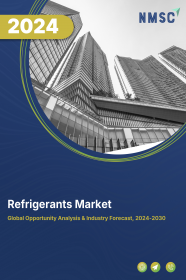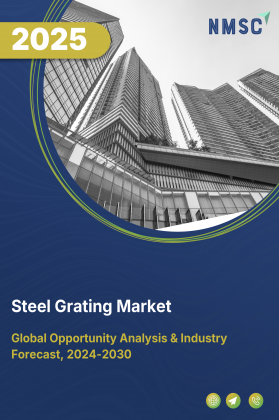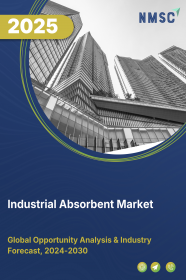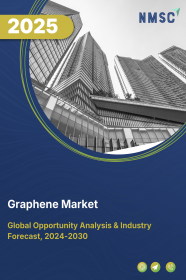
Refrigerants Market by Type (Hydrochlorofluorocarbons (HCFCs), Hydrofluorocarbons (HFCs), Hydrocarbons (HCs), Ammonia (NH3), Carbon Dioxide (CO2), Propane, Halocarbons, Azeotropic, Zeotropic and Inorganic), by Application (Refrigerators, Air Conditioners, Chillers and Others Application), and by End User (HVAC, Automotive, Food and Beverages, Pharmaceuticals, Electronics and Manufacturing) – Global Opportunity Analysis and Industry Forecast, 2024–2030
Market Definition:
The global Refrigerants Market size was valued at USD 21.72 billion in 2023, and is predicted to reach USD 34.43 billion by 2030, with a CAGR of 6.8% from 2024 to 2030. Refrigerants are chemical substances or compounds used in heating, ventilation, air conditioning, and refrigeration (HVAC&R) systems to transfer heat and enable cooling or refrigeration processes. They are crucial for maintaining temperature-controlled environments in various applications, including residential, commercial, industrial, and automotive sectors.
The market encompasses manufacturing different types of refrigerants, compliance with stringent environmental regulations, intricate supply chains for distribution, and ongoing technological innovations. It also endeavors to develop environmentally friendly and energy-efficient alternatives. Refrigerants play a pivotal role in maintaining comfortable living conditions, preserving perishable goods, and supporting industrial processes.
Market Dynamics and Trends
The rising global demand for innovative products and ecologically friendly cooling solutions such as air conditioners, chillers, and refrigerators are driving the growth of the refrigerants market. For instance, in February 2022, Pro-Refrigeration, Inc., a producer and supplier of chillers, created the CO2 chiller concept, significantly affecting the California dairy farm and the environment. With a positive environmental impact, this development is driving the demand for eco-friendly refrigerators in this market.
Furthermore, the increased demand for commercial air conditioning in the burgeoning construction industry influenced the subsequent growth in refrigerant consumption. For Instance, in March 2023, the Federal Transit Administration (FTA) of the U.S. declared that 11 significant rail projects had been recommended to get a share of the USD 4.45 billion allocated for public transportation building projects. These construction projects will increase the demand for heating, ventilation, and air conditioning systems, thus driving the market growth of refrigerants to meet the evolving needs of construction industries.
However, considering the catastrophic harm caused to the ozone layer, various nations and organizations are imposing restrictions to ban hydrocarbon refrigerants. Several countries have decided to progressively phase out hydrofluorocarbons (HFCs) and hydrochlorofluorocarbons (HCFCs) through restrictions on consumption under different regulations and protocols.
For instance, in December 2022, the Environmental Protection Agency recommended limiting certain HFCs in new goods, such as foam blowing, aerosols, air conditioning, and refrigeration. Therefore, such factors are expected to restrain the growth of the refrigerants market during the forecast period.
On the contrary, the introduction of new compressor models indicates a commitment to energy-efficient refrigeration, aligning with the future opportunity for solutions in the refrigerants market. For instance, in May 2023, Embraco introduced three new variable speed compressor models, VEMT, VEH, and VNEX. It is developed for the Chinese market and presented at the Shanghai International Hospitality Equipment & Food Service Expo (Hotelex). These products are appropriate for food service and retail refrigeration equipment as they reduce energy consumption in the food service and retail sector. This will further enhance the growth opportunities for the refrigerants market in the coming years.
Market Segmentations and Scope of the Study
The refrigerant market share is segmented based on type, application, end-user, and region. On the basis of type, the market is divided into hydrochlorofluorocarbons (HCFCs), hydrofluorocarbons (HFCs), hydrocarbons (HCs), ammonia (NH3), carbon dioxide (CO2), propane, halocarbons, azeotropic, zeotropic and inorganic. Based on application, the market is classified into refrigerators, air conditioners, chillers, and other applications.
On the basis of end users, the market is categorized into heating, ventilation, and air conditioning (HVAC), automotive, food and beverages, pharmaceuticals, electronics, and manufacturing. The geographic breakdown and analysis of each of the aforesaid segments include regions, such as North America, Europe, Asia-Pacific, and the Rest of the World (RoW).
Geographical Analysis
The refrigerants market in the Asia-Pacific region is experiencing significant growth and increased demand, due to innovative product offerings and strong financial performance by key industry players, such as Johnson Controls-Hitachi Air Conditioning and Dongyue Group Limited. For instance, in February 2023, Johnson Controls-Hitachi Air Conditioning launched the air365 Max, a new addition to the Variable Refrigerant Flow (VRF) portfolio.
The air365 Max provides a complete solution for HVAC specialists, architects, and building owners. This initiative is driving the demand for advanced refrigerant products in Asia-Pacific by addressing issues, such as temperature stability, air drafts, and seasonal variations.
Also, in March 2023, Dongyue Group Limited stated that the external company sales of the refrigerants segment increased by 30.68% to RMB 4,361,050,000 from RMB 3,337,155,000 in the previous year. The segment results showed a profit of RMB 1,021,356,000. It is an increase of 60.18% from a profit of RMB 637,632,000 in the same period last year. This strong growth in the refrigerant segment indicates a potential growth in the refrigerants market.
Moreover, the adoption of policies for the eco-cooling initiative by intergovernmental platforms in the Asia-Pacific region, represented by the Economic and Social Commission for Asia and the Pacific (ESCAP) in August 2021, emphasizes sustainable cooling practices. It urges nations to address cooling-related environmental issues, including refrigerant emissions. This shift towards sustainable cooling is poised to drive the growth in the refrigerant market as industries adopt eco-friendly refrigerants to comply with these policies.
On the other hand, North America is expected to show a steady rise in the refrigerant market, due to the significant launch of hubs dedicated to reducing impact of global warming by the government agencies in this region. For instance, in August 2022, the North American Sustainable Refrigeration Council (NASRC) launched a new Refrigerant Transition Hub to help retailers shift from high global warming potential (GWP) refrigerants to low GWP refrigerants.
The hub provides neutral information to help retailers make the right decisions and navigate regulation changes implemented by the American Innovation and Manufacturing (AIM) Act. This adoption of eco-friendly refrigerants and reduction in HFC use, influenced the refrigerant market by promoting sustainability and regulatory compliance in this region.
Moreover, innovation and the development of advanced products to lower the harmful effects of the global warming drive the demand for the refrigerants market in this region. For instance, in December 2021, Daikin launched a home comfort product featuring R-32, a refrigerant with only one-third of the global warming impact compared to the refrigerants commonly used in the U.S. and Canada. This introduction made people in North America more interested in using eco-friendly refrigerants, showing a growing preference for environmentally friendly cooling options.
Competitive Landscape
The refrigerants industry comprises of various market players, such as The Chemours Company, Honeywell International Inc, Daikin Industries, Ltd, Arkema S.A, Linde Plc, Air Liquide S.A, Orbia Advance Corporation (Koura),The Dow Chemical Company, AGC Inc, Sinochem Group Co., Ltd, Dongyue Group Co., Ltd, SRF, Limited, Gujarat Fluorochemicals Limited, Navin Fluorine International Limited, Resonac. These market players are adopting product launches and collaborations as their key developmental strategies across various regions to maintain their dominance in the market.
For instance, in March 4, 2025, the Honeywell International Inc., Announced the acquisition of Sundyne for approximately $2.2 billion.The product enhanced the growth of the refrigerants market by offering an innovative solution aligned with evolving environmental standards and industry demands.
Also, in August 22, 2025 the Air Liquide S.A. Signed a binding agreement to acquire South Korea’s DIG Airgas for $2.85 billion ($~3.3 billion), expected to close in the first half of 2026.
Refridgerant Market Key Segments
By Chemical Type
-
Fluorocarbons
-
HFCs
-
HFOs
-
-
Hydrocarbons
-
Propane (R-290)
-
Isobutane (R-600a)
-
Propylene (R-1270)
-
-
Inorganics Refrigerants
-
Ammonia (R-717)
-
Carbon Dioxide (R-744)
-
-
Refrigerant Blends
-
Zeotropic (R-407C, R-410A)
-
Near-Azeotropic
-
-
Secondary Transfer Fluids
-
Brines (salt Solutions)
-
Glycols
-
Other Heat-transfer Fluids
-
By Application
-
Air-Conditioning
-
Residential (Window, Split)
-
Commercial (VRF Rooftop)
-
Automotive HVAC
-
-
Refrigeration Systems
-
Domestic (Household Refrigerators, Freezers)
-
Commercial (Retail, Cold Storage, Food Service)
-
Transport (Truck, Trailer, Container)
-
Industrial Process Cooling
-
-
Standalone Heat Pumps
-
Air-Source
-
Water-Source
-
Geothermal
-
-
Non-Cooling Applications
-
Foam Blowing Agents
-
Aerosols
-
Fire-suppression & Other Niche Uses
-
By Region
-
North America
-
U.S
-
Canada
-
Mexico
-
-
Europe
-
UK
-
Germany
-
France
-
Italy
-
Spain
-
Denmark
-
Netherlands
-
Finland
-
Sweden
-
Norway
-
Russia
-
Rest of Europe
-
-
Asia-Pacific
-
China
-
Japan
-
India
-
South Korea
-
Australia
-
Indonesia
-
Singapore
-
Taiwan
-
Thailand
-
Rest of Asia-Pacific
-
-
Rest of the World (RoW)
-
Latin America
-
Middle East
-
Africa
-
Key Players
-
The Chemours Company
-
Honeywell International Inc.
-
Daikin Industries, Ltd.
-
Arkema S.A.
-
Linde Plc
-
Air Liquide S.A.
-
Orbia Advance Corporation (Koura)
-
The Dow Chemical Company
-
AGC Inc.
-
Sinochem Group Co., Ltd.
-
Dongyue Group Co., Ltd.
-
SRF Limited
-
Gujarat Fluorochemicals Limited
-
Navin Fluorine International Limited
-
Resonac
Report Scope and Segmentation:
|
Parameters |
Details |
|
Market Size in 2023 |
USD 21.72 Billion |
|
Revenue Forecast in 2030 |
USD 34.43 Billion |
|
Revenue Growth Rate |
CAGR of 6.8% from 2024 to 2030 |
|
Analysis Period |
2023–2030 |
|
Base Year Considered |
2023 |
|
Forecast Period |
2024–2030 |
|
Market Size Estimation |
Billion (USD) |
|
Growth Factors |
Rising ecologically friendly cooling solutions. Increasing demand for commercial air conditioning due to expanding construction industry. |
|
Countries Covered |
28 |
|
Companies Profiled |
15 |
|
Market Share |
Available for 10 companies |
|
Customization Scope |
Free customization (equivalent up to 80 working hours of analysts) after purchase. Addition or alteration to country, regional, and segment scope. |
|
Pricing and Purchase Options |
Avail customized purchase options to meet your exact research needs. |

















 Speak to Our Analyst
Speak to Our Analyst

























